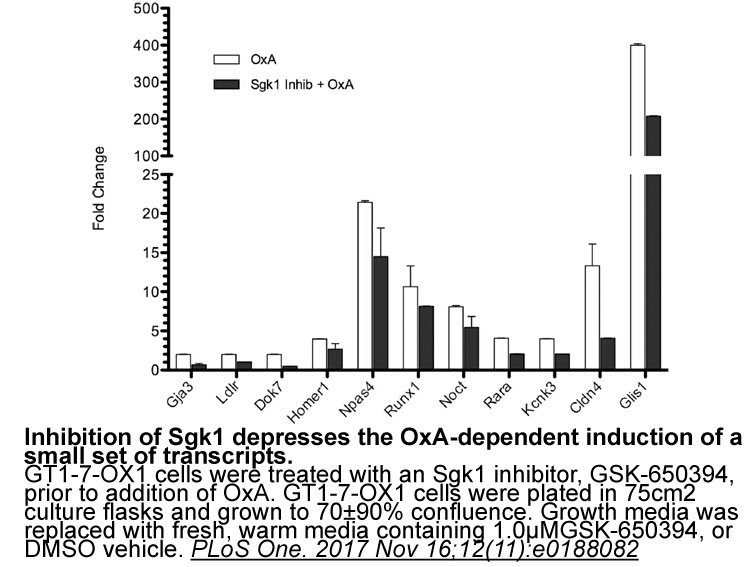Archives
In summary the role of HT
In summary, the role of 5-HT and differe nt types of 5-HTRs in gating plasticity induction in neocortical circuits remains unclear, with variable and seemingly contradictory effects reported for LTP induction in cortical sensory fields (e.g., V1, enhanced LTP: Inaba et al., 2009, Kojic et al., 1997, Kojic et al., 2000, Park et al., 2012; impaired LTP: Edagawa et al., 1998, Edagawa et al., 2000, Gagolewicz and Dringenberg, 2016, Kim et al., 2006). The use of experimental subjects of different species and ages, different induction protocols, and electrophysiological recordings obtained in different cortical layers likely all contribute to the heterogeneous results obtained in previous studies.
The results of the present set of experiments reveal a consistent picture in that the blockade of two main GSK2606414 of 5-HTRs (5-HT2Rs and 5-HT3Rs) impairs LTP and/or converts LTP into LTD. Thus, it appears that the tonic activation of these receptors exerts a permissive and/or facilitating influence over LTP induction in the A1 of adult rodents. Pharmacological treatments targeting serotonergic transmission (e.g., selective serotonin reuptake inhibitors) have shown promise in enhancing synaptic plasticity in the mature nervous system, with potential therapeutic effects, such as the restoration of visual functions in animal models of amblyopia (Ruiz-Perera et al., 2015, Maya Vetencourt et al., 2008). The effects observed in the present set of experiments suggest further, novel strategies for the pharmacological enhancement of synaptic plasticity in the mature nervous system of adult mammals.
nt types of 5-HTRs in gating plasticity induction in neocortical circuits remains unclear, with variable and seemingly contradictory effects reported for LTP induction in cortical sensory fields (e.g., V1, enhanced LTP: Inaba et al., 2009, Kojic et al., 1997, Kojic et al., 2000, Park et al., 2012; impaired LTP: Edagawa et al., 1998, Edagawa et al., 2000, Gagolewicz and Dringenberg, 2016, Kim et al., 2006). The use of experimental subjects of different species and ages, different induction protocols, and electrophysiological recordings obtained in different cortical layers likely all contribute to the heterogeneous results obtained in previous studies.
The results of the present set of experiments reveal a consistent picture in that the blockade of two main GSK2606414 of 5-HTRs (5-HT2Rs and 5-HT3Rs) impairs LTP and/or converts LTP into LTD. Thus, it appears that the tonic activation of these receptors exerts a permissive and/or facilitating influence over LTP induction in the A1 of adult rodents. Pharmacological treatments targeting serotonergic transmission (e.g., selective serotonin reuptake inhibitors) have shown promise in enhancing synaptic plasticity in the mature nervous system, with potential therapeutic effects, such as the restoration of visual functions in animal models of amblyopia (Ruiz-Perera et al., 2015, Maya Vetencourt et al., 2008). The effects observed in the present set of experiments suggest further, novel strategies for the pharmacological enhancement of synaptic plasticity in the mature nervous system of adult mammals.
Experimental procedures
Conflict of interest
Acknowledgement
This work was supported by the Natural Sciences and Engineering Research Council of Canada (NSERC).
Introduction
Evolutionarily, the inhibition of pain can be considered a defense response to an aversive or harmful stimulus (Butler and Finn, 2009). Several emotional responses related to aversive stimulus, such as fear, anxiety, and panic may inhibit or reduce sensitivity to pain (Canto-de-Souza et al., 1998; Nunes-de-Souza et al., 2000). Moreover, the descending inhibitory pain pathway is an important mechanism by which the interaction between processes induced by nociceptive stimuli and fear of stimuli can lead to the inhibition of pain or analgesia (Bolles and Fanselow, 1980; Helmstetter and Fanselow, 1987; Bolles and Fanselow, 1980; Fardin et al., 1984; Miczek et al., 1982; Rodgers, 1995; Siegfried et al., 1990; Terman et al., 1984; Watkins and Mayer, 1982).
From this viewpoint, previous studies have demonstrated that the exposure of rodents to the elevated plus maze (EPM), a widely used test to study anxiety in animals (e.g., Carobrez and Bertoglio, 2005), can also elicit antinociception (Stephens et al., 1986; Lee and Rodgers, 1990; Taukulis and Goggin, 1990; Conceição et al., 1992). We have previously shown that the confinement of mice to the open arm (OA) of the EPM markedly reduces the nociceptive response (Nunes-de-Souza et al., 2000; Baptista et al., 2009; Baptista et al., 2012), a phenomenon described as OA antinociception (OAA).
Systemic and intracerebral injections of anti-anxiety drugs have been used to investigate the OAA underlying mechanisms (Jiménez-Velázquez et al., 2006; Gomes and Nunes-de-Souza, 2009; Nunes-de-Souza et al., 2000; Paul et al., 2002). In this context, considering the role of the amygdaloid complex in the modulation of nociceptive and emotional states (Fields, 2000), this area became one of the most important sites for these pharmacological manipulations (e.g., Nunes-de-Souza et al., 2000; Baptista et al., 2009).
The serotonergic system is one of the several neurotransmitter systems located in the amygdala and is involved in the modulation of defensive responses (File et al., 1981; Graeff, 1981; Hodges et al., 1987). Serotonin, an indoleamine, plays a significant role in nociceptive transmission control, either by increasing or attenuating pain (Heinricher et al., 2009). Several studies have used selective serotonin reuptake inhibitors (SSRIs) as pharmacological tools to demonstrate the serotonergic system role on modulation of the nociceptive behavior (Salerno et al., 2002; Tomkins et al., 2001; McCleane, 2008; Jung et al., 1997; Stone et al., 2003; Duman et al., 2004; Kesim et al., 2005). For instance, Complementation assay has been demonstrated that fluoxetine, an SSRI, provokes antinociception assessed in the paw formalin (Sawynok et al., 1999; Pedersen et al., 2005) and hot plate tests (Singh et al., 2001; Schreiber and Pick, 2006; Hache et al., 2012). In addition, administration of fluoxetine produced antinociceptive effects in both writhing and tail flick tests (Singh et al., 2001; Pedersen et al., 2005; Sikka et al., 2011).